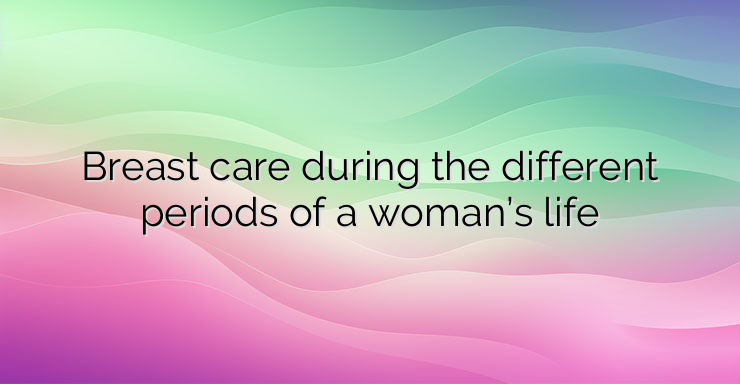The mammary glands are a pair of organs and are modified sweat glands. They are located on the pectoralis major muscle and consist of 15-20 tubulo-alveolar glands. The main function of the mammary glands is related to milk production during the lactation period. There are some important rules in the care of the mammary glands, which reduce the risk of developing oncological diseases and infections during breastfeeding. The breast consists of a body – corpus mammae, and a nipple – pupilla mammae. In the center of the gland is a hyperpigmented area called the areola. Histologically, mammary glands consist of two main components – glandular parenchyma and stroma. The stroma is represented by fat and connective tissue, and the glandular parenchyma – by 15-20 lobules. The ratio between glandular parenchyma and stroma is different during different periods of a woman’s life. During pregnancy and lactation, the glandular parenchyma increases, while during the remaining periods, the glandular stroma predominates in a larger quantity. The main function of the mammary glands is lactation. During pregnancy, under the influence of estrogens, progesterone, growth hormone, etc., the volume of the glandular parenchyma increases and the secretion of the glandular cells is stimulated. Immediately before birth and after birth, the mammary glands begin to secrete milk. Of primary importance in the secretion of milk is the hormone prolactin, which is released from the anterior lobe of the pituitary gland. During breastfeeding, high levels of prolactin suppress the secretion of luteinizing hormone and follicle-stimulating hormone, which leads to suppression of ovulation and the so-called. lactational amenorrhea. What are the basic cares every woman should take for her breasts? 1. Breast self-examination – it is recommended to start breast self-examination from the age of 21. It is done every month after menstruation and is especially recommended for women with a family history, having relatives who have suffered from breast cancer. The self-examination is performed as the woman stands, undressed to the waist, in front of a mirror. One hand is placed on the back of the head, and with the palm of the opposite hand, the corresponding breast is examined in quadrants, finally pressing the nipple to check for discharge. Breasts are checked for tenderness and formations. They look for redness, discharge, change in shape. After palpation of the chest, it is advisable to proceed to palpation of the axillary fossa, where the axillary lymph nodes are located. Palpation of enlarged lymph nodes in the area should direct the patient to consult a mammologist. 2. Ultrasound examination of mammary glands – recommended for all women under 35 years of age. A safe, non-invasive, highly informative method for establishing benign and malignant diseases of the mammary glands. It is recommended to be carried out once a year, and when formations are detected and more often, according to the recommendations of the mammologist; 3.Carrying out mammography – mammography is an X-ray examination of the mammary glands, which is done in two projections – cranio-caudal and latero-medial. Mammography is performed 5 to 12 days after the date of the last menstrual period. Women over the age of 40 should have an annual screening of the mammary glands by mammography; 4. Care of the mammary glands during pregnancy and lactation – the care during this period is more specific. Breast care before birth consists of daily examination. In case of discharge from the nipples, it is recommended to wear special pads for nursing mothers. For flat and indented nipples, to prepare them for breastfeeding, it is good to perform daily massage and pulling. This practice is prohibited in women with frequent contractions and an increased risk of premature birth, as stimulation of the nipples increases the production of oxytocin. In the first days after birth, the secretion of colostrum begins – a yellowish, thick liquid, rich in minerals, proteins, antibodies, lactoferrin, etc. Before each breastfeeding, it is recommended that the woman wash and dry her breasts, and after breastfeeding – to squeeze them. Using nipple cream prevents inflammation and facilitates breastfeeding. In some cases, it may be necessary to use silicone beads. Breast care both during pregnancy and in the non-pregnancy period is extremely important for the health of every woman. Regular preventive examinations from an early age prevent the development of serious diseases such as breast cancer, and appropriate breast care during pregnancy and breastfeeding prevent the development of severe postpartum inflammations (eg mastitis).even in the non-pregnancy period, it is extremely important for the health of every woman. Regular preventive examinations from an early age prevent the development of serious diseases such as breast cancer, and appropriate breast care during pregnancy and breastfeeding prevent the development of severe postpartum inflammations (eg mastitis).even in the non-pregnancy period, it is extremely important for the health of every woman. Regular preventive examinations from an early age prevent the development of serious diseases such as breast cancer, and appropriate breast care during pregnancy and breastfeeding prevent the development of severe postpartum inflammations (eg mastitis).


Leave a Reply